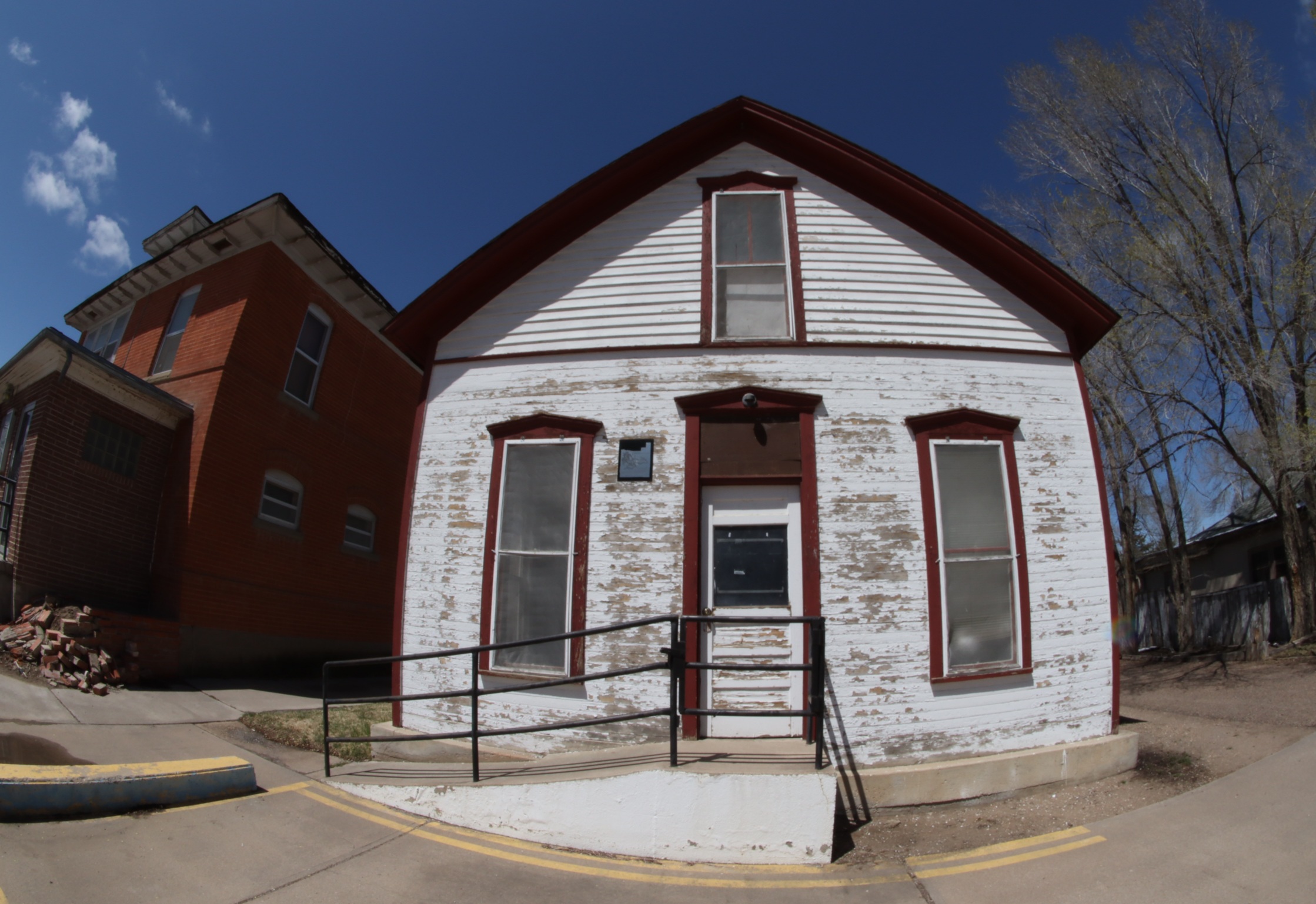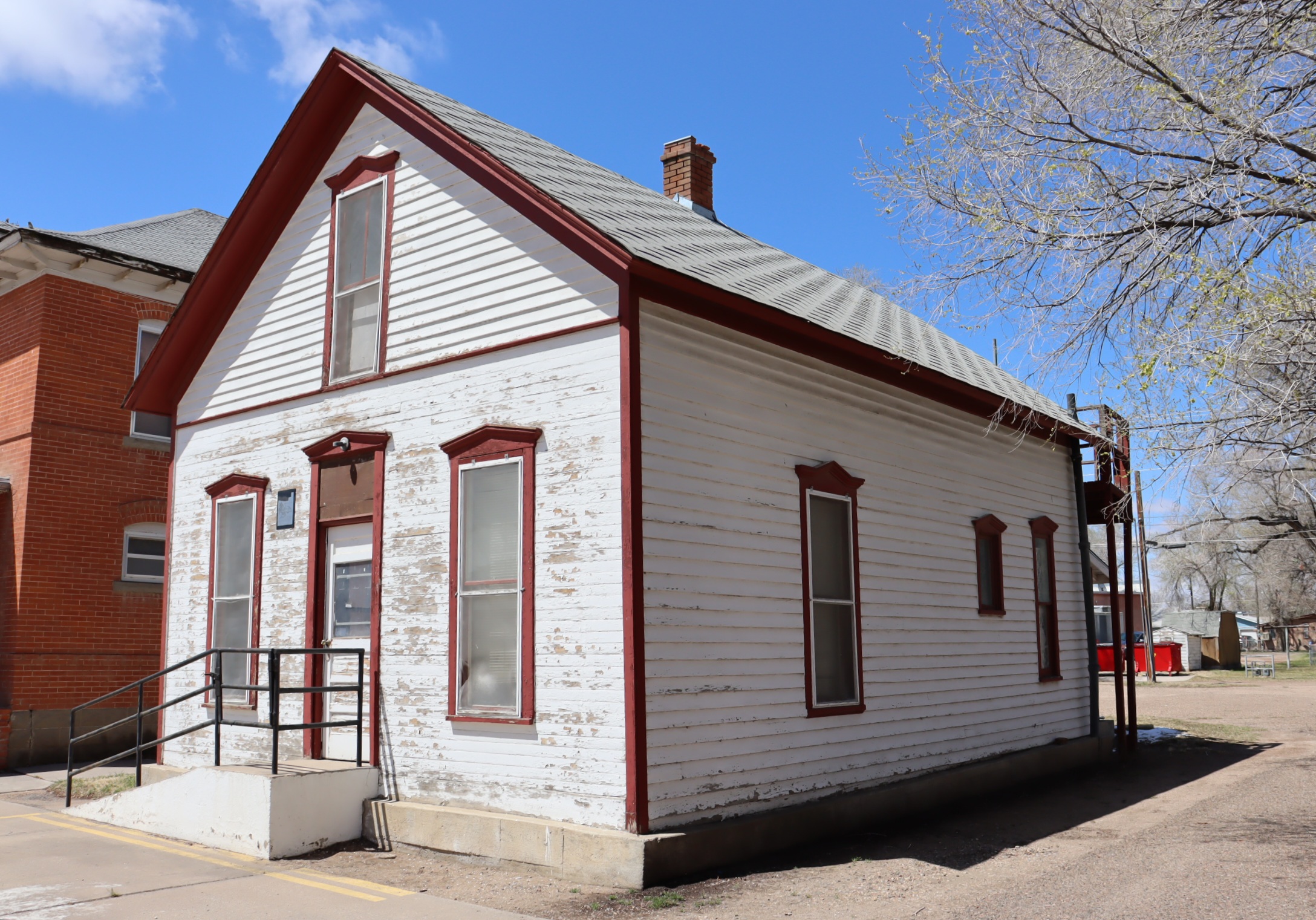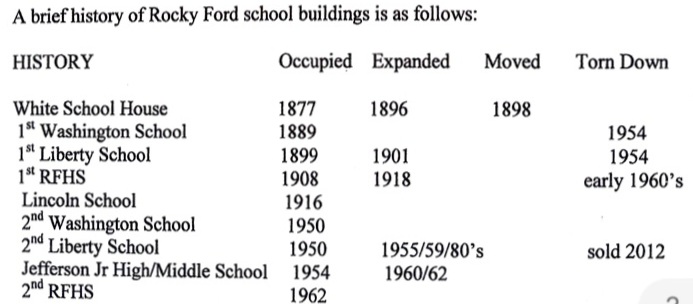Rocky Ford's Little White School House - Otero County Register of Historic Places '09

Description: Rocky Fords First School House is Becoming a Friends of the Rocky Ford Museum Restoration Project as Valley Wide Health Systems has Donated the Historic Building...The Little White School House...

"Little White School House" History of the First Rocky Ford School
Featuring: Excerpts from Otero County Register of Historic Places & Sites in Rocky Ford
Rocky Ford's first school house was home to the townships first election and holds local history within its walls. The most recent chapter in its history begins with restoration by the Friends of the Rocky Ford Museum as it has been donated to them by Valley Wide Health Systems.
The Following is part of research and reports submitted by Donna Abert for the Otero County Register of Historic Places & Sites in Rocky Ford-approved January, 2009 by Otero County Commissioners.
Designated as Otero County Historical Building With History of the Development of Schools in the Present R-2 School District
By: Donna Abert
George W. Swink served with Abraham Lincoln in the Republican Party in Illinois. He was invited to and attended Lincoln's funeral. As Lincoln molded the nation, Swink molded Rocky Ford and the surrounding area. He first saw the area as the Indians, Spanish, Mexicans and Zeb Pike saw it-prairie lands extending as far as the eye could see. In his dreams for the area, he saw education as a key factor in providing reasons for the area to grow and prosper. As Rocky Ford moved in 1876 from the Arkansas River to a site next to the completed Santa Fe railroad tracks that stretched throughout the Arkansas Valley, a plat of the city was drawn with the school area a prominent part of the document.
Since we were originally part of Bent County before Otero County was formed, the plat was recorded at the county seat in Las Animas on July 4, 1876. There were few permanent buildings in this area of the state when the adobe 15' x 15' school building was constructed in 1877 for 15 to 18 students. It was then the only permanent school building in the West Bent County School District (organized 1874) that extended 91 miles north/south and 38 miles east/west and the first schoolhouse in the township of Rocky Ford. Ten years later, Rocky Ford held its first election in the building on August 6, 1887, when George Swink was elected mayor and J.P. Stevenson, J M. Hendricks, E. H. Capron, Jeff Burson, W. H. Brandenburg and William Rudolph were elected trustees. To have these elections certain procedures were followed according to the general statues of Colorado of 1883. First a petition had to be filed with a clerk in the county court. Then on July 13, 1887, the country commissioners J. D. Dye, W. H. Brandenburg, J. S. Seely, I. Dennes and G. W. Swink (who had been appointed to the county court) published a Notice of Election. The Notice of Election for incorporation was to be held at the school house. In Rocky Ford as the School Children See It, they said "the school house just mentioned was the "Little White School House," the place of all important meetings at the time." So, in Rocky Ford both the two elections and the city ordinances that followed happened in the 15' x 15' one room adobe school building that was weathered boarded and painted white.
In the September 18, 1967, Rocky Ford Daily Gazette, Mattie Swink Lamon {George . W. Swink's daughter) was quoted as saying Sunday school, church box socials, political and literary meetings were held at the school house. The first Christmas tree was set up in the 1879, according to an article by Jose Ortega of La Clinics in the December 24, 1986, edition of the Daily Gazette. According to John Doll in The Story of Rocky Ford, the meeting to organize the Methodist Church was held in the White School House on March 5, 1887; the first Mass was celebrated in the White School House in 1888. It was truly the center of life in Rocky Ford from 1877 throughout the 1880s. There had been earlier school classes held in homes and other building in outlying areas, but this was the first school house in the township of Rocky Ford. This building was later expanded in 1896 when the sugar factory was being built and new families were moving to town. It was then moved in 1898 from its location on the block of 10th and Swink to its present location at 407 North 12th Street. At that time, construction at that location for the first Liberty School was started. Today, Nava Manor and the Colorado Extension Service are located on this property.
On January 2, 2009, Building Inspector Jim Cope examined the building at 407 North 12th Street in hopes of finding an entrance underneath the building. He was looking for evidence of additions to the original 15' x 15 building. He found all entrances or openings at ground level had been blocked when the new forced air heating system was installed. There was a partial hole in the closet in the north front room. A board restricted entrance. In the added on back porch that sits over a basement, there was no entry in the basement to go under the rest of the house. However, in the room you enter at the front door, he found yellow pine floor planks that were used in the mid-19th century. These planks are 4 to 5 inches across. He did this by pulling back the carpet next to air ducts on the floor of this 15' x 14 ½ 'room. The rest of the building on both floors has planks that are 10 to 12 inches wide. These wider planks were used at the end of the 19th century which was the time of the expansion of the building. The room you enter at the front door is also where there is a chimney and covered flu that extends today upward through the second floor. A pot belly stove could have been the source of heat through that chimney and flu in 1877 in that original 15' x 15' building that is the front room you walk into today.
The outside front of the present day building on the first level has older siding different from the rest of the structure. It looks like bead boards and is similar to boards that were the material for box cars. With very few trees in the area in 1877 and lack of stores in the area, this material would have been available at a low price from the railroad to weatherboard the 15' x 15' one story adobe building. This weatherboarding then could have been applied to the remodeled and expanded building as nothing was wasted in pioneer days. A different siding was used on the enlarged building on the outside front top floor and the sides of the expanded building. It is the size and type of siding used at the turn of the century in the late 1890's for wooden buildings. So, in the 1898 expanded White School House there is definitely old and new material used both in the floors and outside siding. Ron Goebel, who did early research on the building, said the late Rocky Ford historian John Doll's notes said the adobe at some point was removed from the school house. Ron did not specify if this was when the building was expanded or just before the move to North 12th Street. We also know adobe was used as early insulation between walls for the pioneers. With spot checks, no adobe can be found in the building today.

The entire foundation is limestone that was easily obtainable in 1877 and 1896 in the "Cedars" south of La Junta. This includes limestone between the two front rooms. The outside concrete around the building was probably done at a later time to reinforce the foundation. Another observable feature of the construction is there is no top plate between the outside and inside walls at the second story level. This was typical of construction in the late 19th century. This was observed by both Frank Burchett and Jim Cope. The expanded building is a two story 30' x 28' building with a 9 x 15 back porch. A balcony with a wooden fire escape is at the rear of the building.
Jenn Laura Walker Dawley was the 3rd child born in Rocky Ford after the Swink sisters, Mattie and Belle, were born. Many times she pointed out the building at 407 N. 12th St. to her granddaughter, Norma Jean Dawley Cannon saying the building was the "Little White School House" that she attended as a child. Edwin Deweese, whos; father was a first cousin to Mrs. G. W. Swink, came to Rocky Ford in the late 1800's and also conveyed the same information about the building. Ed said in the 1920's his Dad pointed to the building where the Eccles family was then living and identified it as the White School House. This information was told to John Doll by Ed Deweese and is on page 20 of John Doll's book, "The Story of Rocky Ford."
The lot# given in the book for location is 3(It is the 3rd property numbered on that block.) However, the actual building, standing where it is today, was pointed out to Norma Cannon by her grandmother and to John Doll and Donna Abert by Edwin Deweese. So, the discrepancy of the lot# is probably a human error by word of mouth or transcription. According to Rocky Ford As the School Children See It, the building was originally purchased by a Mr. Marble in 1898 and moved to property originally owned by the Swink family. Since survey records in the court house only show the ownership of the land, it is not known the circumstances of these transactions. Mr. Marbles' name does not appear as owner of this property at the court house. After the building was moved, it was no longer used as a school house. It was both a residence and rental for its owners, but in recent years was used for doctor offices for "La Clinica," a health service.
Today, in 2010, it is owned by Valley Wide Health Services, Inc. of Alamosa and is used for storage. It is well maintained. If we go back in the past, quoting the Rocky Ford's 75th Anniversary edition of the Daily Gazette, we can picture the first school house with four rows of desks, each desk seating five pupils. There were two pictures, one of Washington and one of Lincoln in the room. Only slates were used, and each child had three books, a Blue Back speller, an arithmetic book and a reader. Only church hymns were sung. Mr. Blake was the first school teacher. The White School House is the only school building that survives other schools (Washington and Liberty) constructed before the turn of the century. It also survives the first Rocky Ford High School that was built in 1908 and torn down in the 1960's.

Follow SECO News on Facebook.
Subscribe to the SECO News YouTube Channel.





.png)







.png)


.png)







